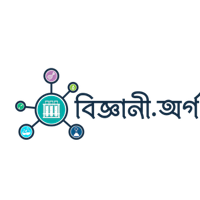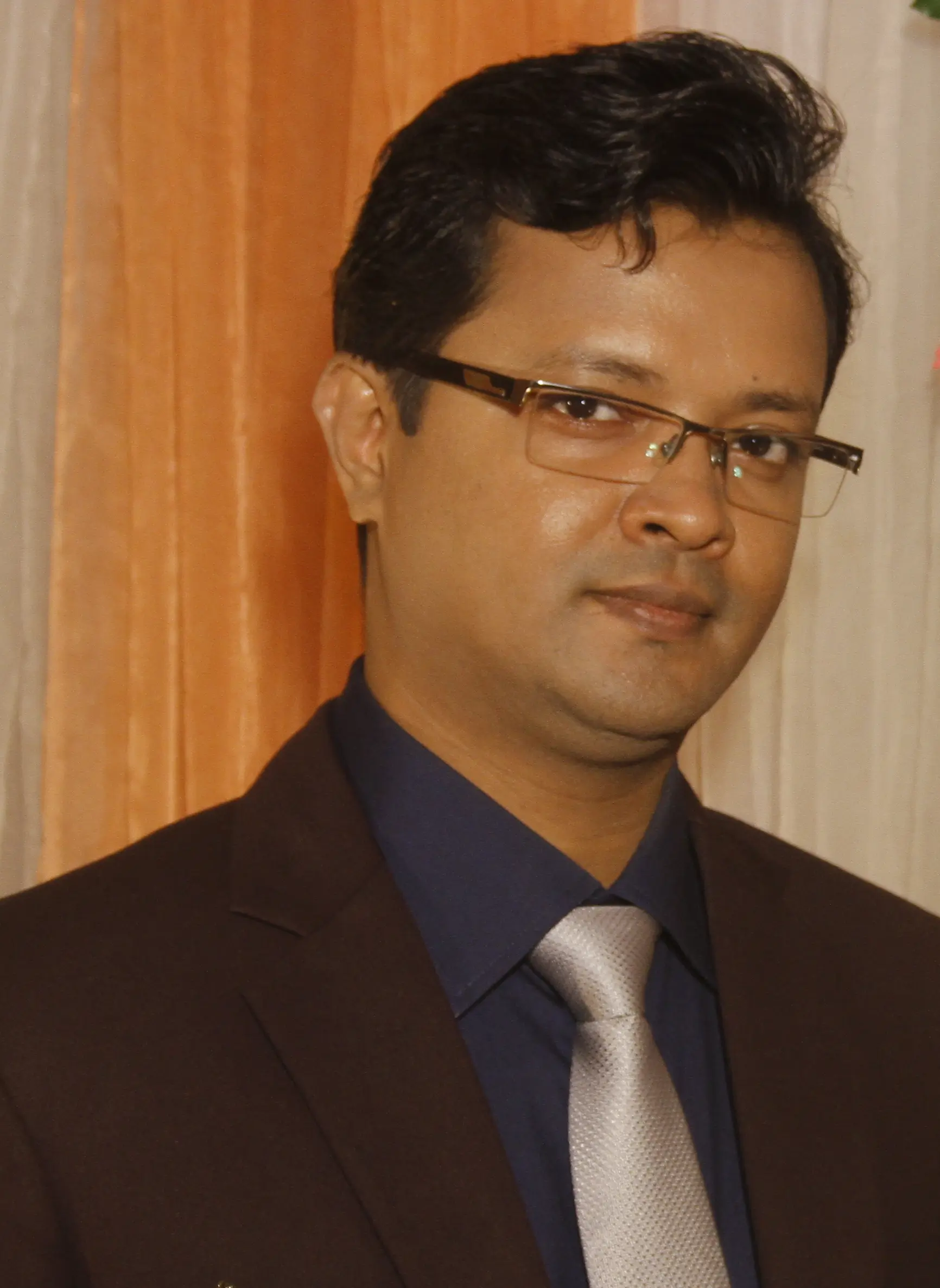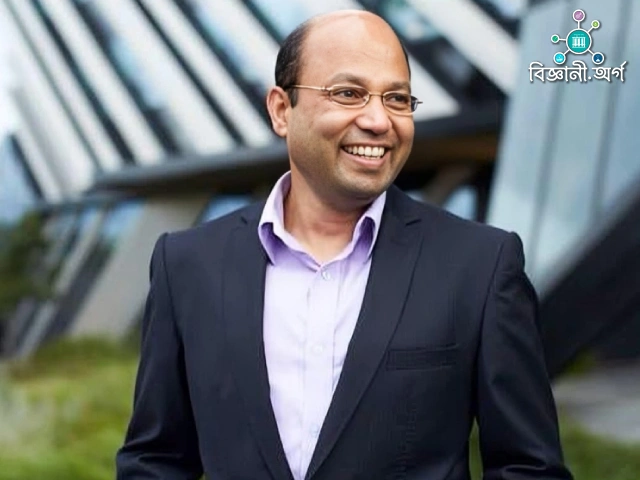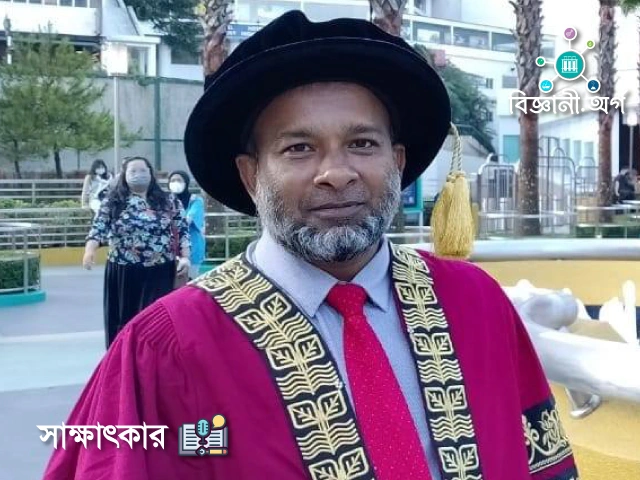আরিফ রেজা আনোয়ারি বর্তমানে যুক্তরাজ্যের Bournemouth University-তে গবেষক হিসেবে কর্মরত। তিনি পূর্বে বাংলাদেশের United International University-এর কম্পিউটার বিজ্ঞান ও প্রকৌশল বিভাগে সহকারী অধ্যাপক ছিলেন। তিনি যুক্তরাজ্যের University of Wolverhampton থেকে “Statistical Shape Analysis for the Human Back” নামে এম.ফিল ডিগ্রি অর্জন করেছেন। এর আগে দক্ষিণ কোরিয়ার Gyeongsang National University থেকে কম্পিউটার বিজ্ঞানে এম.এসসি এবং বাংলাদেশের University of Asia Pacific থেকে কম্পিউটার বিজ্ঞান ও প্রকৌশলে স্নাতক সম্পন্ন করেছেন।
তার গবেষণার মূল ক্ষেত্রসমূহ হলো Internet of Things (IoT), Human Gait Analysis, Computing for Human Experience (CHI), Human-Robot Symbiosis, এবং Cognition for Autonomous Agents। বাংলাদেশ ও আন্তর্জাতিক উভয় পরিবেশেই তিনি গবেষণা করছেন এবং শিক্ষার্থীদের জন্য উদ্ভাবনী পথ তৈরিতে যুক্ত রয়েছেন।
💬 প্রশ্নোত্তর পর্ব:
প্রশ্ন: বাংলাদেশে গবেষণা করে এখন আপনি যুক্তরাজ্যে গবেষণা করছেন। যুক্তরাজ্যে কাজ করতে কেমন লাগছে?
উত্তর: গত এক দশকেরও বেশি সময় ধরে আমি বিভিন্ন একাডেমিক, সংগঠনভিত্তিক ও আন্তঃবিষয়ক প্রকল্পে কাজ করেছি, যার সহায়তা পেয়েছি এশিয়া প্যাসিফিক বিশ্ববিদ্যালয়, ইউনাইটেড ইন্টারন্যাশনাল ইউনিভার্সিটি, এক্সেস টু ইনফরমেশন (A2I) ও আইসিটি মন্ত্রণালয়ের কাছ থেকে। বাংলাদেশে কাজ করার সময়ের অভিজ্ঞতাগুলো ছিল অত্যন্ত আনন্দদায়ক। দেশ উন্নয়নের জন্য উদ্ভাবনের বিকল্প নেই—এ কথা সরকার ও বিশ্ববিদ্যালয় উভয়ই উপলব্ধি করতে শুরু করেছে। ‘ডিজিটাল বাংলাদেশ’ কর্মসূচির অধীনে নেওয়া উদ্ভাবনী উদ্যোগগুলো ভবিষ্যতে শিক্ষা ও অর্থনীতিতে ইতিবাচক প্রভাব ফেলবে।
যুক্তরাজ্যে গবেষক হিসেবে কাজ করা মানে এক বিশাল সুযোগ—এখানে গ্রন্থাগার, ল্যাবরেটরি ও গবেষণা সহযোগিতা সবই সহজলভ্য। Bournemouth University-তে গবেষণা করার সুযোগ পেয়ে আমি নিজেকে সৌভাগ্যবান মনে করি।
প্রশ্ন: আপনার বর্তমান গবেষণার বিষয়বস্তু কী?
উত্তর: আমি বর্তমানে গেইট অ্যানালাইসিস বা মানব হাঁটার ধরণ বিশ্লেষণ নিয়ে গবেষণা করছি। প্রতিটি মানুষের হাঁটার ধরণ বা gait সাধারণত সমমিত হওয়া উচিত। তবে বয়স, রোগ বা অন্যান্য কারণে এই সমতা নষ্ট হলে তা শারীরিক অসুস্থতার ইঙ্গিত দেয়। আমরা তরুণ ও প্রবীণ ব্যক্তিদের হাঁটার ভিন্নতা বিশ্লেষণ করে অস্বাভাবিক gait শনাক্ত করছি। এই উদ্দেশ্যে আমরা একটি কম খরচের পরিধানযোগ্য সেন্সর-ভিত্তিক গেইট মনিটরিং সিস্টেম তৈরি করছি, যা প্রবীণদের পড়ে যাওয়ার ঝুঁকি আগেভাগেই নির্ধারণে সহায়তা করবে।
উল্লেখযোগ্য যে, Bournemouth University-র এক প্রকল্পে “Sensor-integrated Urometer for measuring real-time urine output” নামে একটি সহায়ক প্রযুক্তি তৈরি করা হয়েছে, যেখানে আমি অংশ নিয়েছি। (blogs.bournemouth.ac.uk)
প্রশ্ন: কেন আপনি এই বিষয়ে গবেষণা করছেন?
উত্তর: বিশ্বজুড়ে প্রবীণ জনগোষ্ঠীর সংখ্যা দ্রুত বাড়ছে। যুক্তরাজ্যে প্রতি বছর তিনজনের একজন প্রবীণ মানুষ পড়ে গিয়ে আঘাত পান—এটি একটি গুরুত্বপূর্ণ স্বাস্থ্য সমস্যা। হাঁটার ধরণ বা gait-এ ভঙ্গ/অবিচ্ছিন্নতা পতনের ঝুঁকিকে নির্দেশ করতে পারে। যদিও অনেক গবেষণা হয়েছে, দীর্ঘমেয়াদে gait-প্যাটার্ন পরিবর্তন বিশ্লেষণ করে পতনের পূর্বাভাস দেওয়া এখনো কঠিন। তাই আমি এই চ্যালেঞ্জটিকে গবেষণার কেন্দ্রবিন্দুতে রেখেছি।
প্রশ্ন: রোবটিক্স ভবিষ্যতে কী ধরনের ভূমিকা রাখতে পারে বলে আপনি মনে করেন?
উত্তর: রোবটিক্সের আধুনিক যুগ শুরু হয়েছে শিল্পবিপ্লবের ধারাবাহিকতায়। এখন আমরা ইন্ডাস্ট্রি ৪.০ যুগে প্রবেশ করেছি, যেখানে সাইবার-ফিজিক্যাল সিস্টেম, কৃত্রিম বুদ্ধিমত্তা (AI), ক্লাউড কম্পিউটিং ও ইন্টারনেট অফ থিংস একসাথে কাজ করছে। রোবটিক্স শিল্প উৎপাদন থেকে স্বাস্থ্যসেবা—সব ক্ষেত্রেই গুরুত্বপূর্ণ হয়ে উঠছে। উদাহরণস্বরূপ, শিল্প রোবটিক্স প্রকল্প দেখায় যে রোবটিক্স অর্থনীতির জন্য ভালো প্রভাব ফেলছে।
এছাড়া রোবটিক্স ইঞ্জিনিয়ারদের বেতন-রেঞ্জও দেখায় যে এই ক্ষেত্রটি চাকরির ক্ষেত্রে গুরুত্বপূর্ণ ভূমিকা নিচ্ছে। (roboticstomorrow.com)
প্রশ্ন: বাংলাদেশের মতো দেশে রোবটিক্সের বাস্তব প্রয়োগ কতটা সম্ভাবনাময়?
উত্তর: রোবটিক্স আসলে একটি আন্তঃবিষয়ক ক্ষেত্র—যেখানে মেকানিক্স, সেন্সর, মোটর কন্ট্রোল, কৃত্রিম বুদ্ধিমত্তা সবকিছু একত্রে কাজ করে। বাংলাদেশের শিক্ষার্থীরা রোবটিক্সে আগ্রহী হচ্ছে, যা খুব ইতিবাচক দিক। আমাদের দেশে এখন শিল্প অটোমেশন, কৃষি, স্বাস্থ্য ও ই-কমার্সে কৃত্রিম বুদ্ধিমত্তার প্রয়োগ বাড়ছে। বিশ্ববিদ্যালয় পর্যায়ে সেমিনার, প্রদর্শনী ও প্রকল্প-ভিত্তিক শিক্ষা তরুণদের উদ্যোক্তা হতে সাহায্য করছে।
বিশ্বব্যাপী অর্থনীতির দিকেও দেখা গেছে, বড় বড় অর্থনীতিতে আগামী বছরগুলোতে প্রবৃদ্ধি থাকবে। (Statistics Times) এই প্রসঙ্গে বাংলাদেশের জন্য রোবটিক্স ও অটোমেশন শিল্প একটি সম্ভাবনাময় ক্ষেত্র হয়ে উঠতে পারে।
প্রশ্ন: প্রবাসে থেকেও আপনি বাংলাদেশের তরুণদের নিয়ে কাজ করছেন—সে বিষয়ে কিছু বলুন।
উত্তর: আমরা বেশ কিছু প্রকল্প করেছি যেমন — Refreshable Digital Braille Display, Accessible Dictionary, Daisy Player, Braille Learning Kit, Accessible Medicare, Automatic Urometer, Smart Sitting Monitor, এবং e-cigarette Puff Detection। এগুলো দৃষ্টিপ্রতিবন্ধী ও শারীরিকভাবে অক্ষম ব্যক্তিদের জন্য সহায়ক প্রযুক্তি হিসেবে কাজ করছে। বিস্তারিত প্রকল্পের তালিকা আমার ওয়েবসাইটে পাওয়া যাবে। http://robotbangla.com/arifreza/inner_page/Projects/Projects.html
প্রশ্ন: তরুণ শিক্ষার্থীদের জন্য আপনার কোনো উপদেশ?
উত্তর: “সৃজনশীলতা একটি নবায়নযোগ্য সম্পদ। যতবার ইচ্ছে, যতভাবে ইচ্ছে সৃজনশীল হোন—কারণ এটি কখনও শেষ হয় না।”
🔗 প্রোফাইল লিংক:
http://robotbangla.com/arifreza/inner_page/Projects/Projects.html
আরিফ রেজা আনোয়ারির গবেষণা মানবজীবনের মানোন্নয়ন, প্রবীণ নিরাপত্তা এবং প্রযুক্তি-নির্ভর সমাজ বিনির্মাণে গুরুত্বপূর্ণ অবদান রাখছে। বাংলাদেশ ও বিদেশে তার কাজ তরুণ গবেষকদের জন্য অনুপ্রেরণার উৎস হয়ে উঠেছে। বিজ্ঞানী.অর্গ টিম তার ভবিষ্যৎ গবেষণার সাফল্যের জন্য শুভকামনা জানাচ্ছে এবং আশা করছে, তার উদ্ভাবন আগামী প্রজন্মের বিজ্ঞানীদের নতুন দিগন্তে পৌঁছে দেবে।
Pushing the Boundaries of Science – Arif Reza Anwary’s Research Journey
His current research focuses on Internet of Things (IoT), Human Gait Analysis, Computing for Human Experience (CHI), Human-Robot Symbiosis, and Cognition for Autonomous Agents. His work bridges practical technology and healthcare applications, including gait monitoring systems for elderly fall prevention. He is actively involved in mentoring young researchers and supporting technology-driven innovation both in Bangladesh and abroad.
💬 Q&A Session:
Q: How does it feel to conduct research in the UK after working in Bangladesh?
A: Over the past decade, I have worked on multiple academic, organizational, and interdisciplinary projects supported by Asia Pacific University, United International University, A2I, and the ICT Ministry. While I thoroughly enjoyed research in Bangladesh, the UK provides unique resources for academic work. Researchers here have access to advanced libraries (including paid articles), laboratories across multiple disciplines, and opportunities for international collaboration. I feel fortunate to conduct research at Bournemouth University, benefiting from these facilities.
Q: What is the focus of your current research?
A: I am currently researching human gait analysis. Ideally, an individual’s gait is symmetrical, but asymmetry can indicate disease or increased risk of falls. We analyze gait variability between young and elderly people to identify abnormal patterns and quantify changes over time. For this, we have developed an affordable, wireless, multi-sensor personalized gait monitoring system that assesses elderly fall risk and monitors gait asymmetry. This research is part of a broader effort at Bournemouth University, which includes projects like the Sensor-Integrated Urometer for real-time urine output measurement. (Project Link)
Q: Why did you choose this research area?
A: The global elderly population is rapidly increasing. For example, in the UK, one in three people over 65 falls each year. Falls are a significant health concern in the US, Australia, and Asia as well. Long-term gait pattern monitoring and fall prediction remain challenging despite prior research. I am motivated to investigate gait variability over time to detect abnormalities and reduce fall-related risks, improving elderly quality of life.
Q: What role do you see robotics playing in the future?
A: Modern robotics began with the Industrial Revolution. Now, Industry 4.0 integrates cyber-physical systems, AI, cloud computing, and IoT, expanding robotics’ impact across healthcare, manufacturing, and automation. Robotics also positively influences the economy: studies show industrial robots boost productivity and economic growth. (ZDNet Article) Additionally, robotics engineers command high salaries in developed economies, reflecting growing demand. (RoboticsTomorrow)
Q: What potential does robotics have for countries like Bangladesh?
A: Robotics is interdisciplinary, covering mechanics, motor control, sensors, AI, and computing. While Bangladesh currently has few companies in industrial automation, there is significant potential in manufacturing, agriculture, healthcare, and e-commerce. With proper investment in training and technology, robotics can expand career opportunities, increase exports, and enhance Bangladesh’s position in the global economy. (Projected GDP Reference)
Q: You continue to work with young Bangladeshi students from abroad. Could you tell us about some projects?
A: We have developed Refreshable Digital Braille Displays, Accessible Dictionaries, Daisy Players, Braille Learning Kits, Accessible Medicare, Automatic Urometers, Smart Sitting Monitors, and e-cigarette puff detection systems. These projects focus on accessibility and healthcare technology. Detailed project information is available online. (Projects List)
Q: Any advice for young students interested in science?
A: “Creativity is a renewable resource. Be as creative as you like, as often as you can, because you can never run out of it!”
🔗 Profile Link:
http://robotbangla.com/arifreza/inner_page/Projects/Projects.html
Arif Reza Anwary’s research in gait analysis, robotics, and healthcare technology is contributing to improved elderly quality of life and advancing interdisciplinary innovation. His work inspires young scientists in Bangladesh and abroad to pursue impactful, technology-driven research. The biggani.org team wishes him continued success and hopes his projects serve as a model for future scientific innovation globally.











Leave a comment